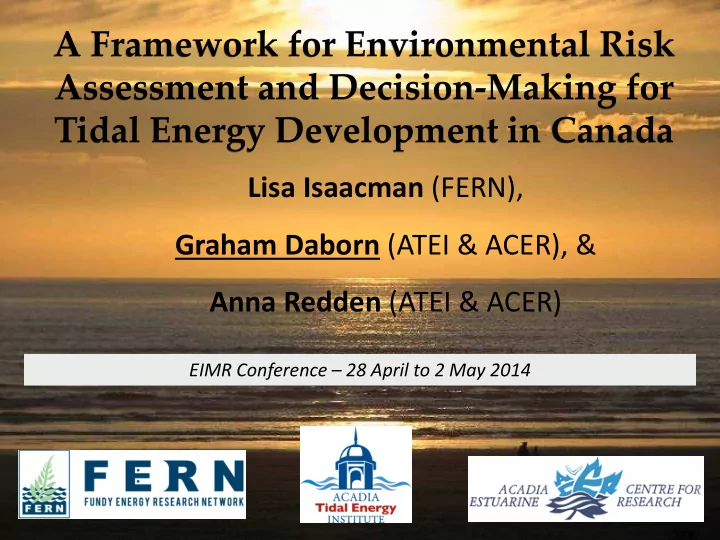

A Framework for Environmental Risk Assessment and Decision-Making for Tidal Energy Development in Canada Lisa Isaacman (FERN), Graham Daborn (ATEI & ACER), & Anna Redden (ATEI & ACER) EIMR Conference – 28 April to 2 May 2014
<2.5 m/sec < 2 m/sec Tidal lagoon < 6 m/sec Scots Bay Tidal 1-2 m/sec Range Proposal Annapolis TGS www.mar.dfo-mpo.gc.ca , 2002 Tidal Power Options in the Bay of Fundy
We live (and work) in……. • A dynamic, inadequately known environment that: – Exhibits high temporal & spatial variation; – Is constantly changing (naturally); – Is constantly changing (for anthropogenic reasons). • i.e. It is a system that is not in equilibrium.
We are working with…. • A challenging (and unforgiving) environment. • Migratory species, some of which are ‘at risk’, and are shared with other regions. • New, largely untested TISEC technologies whose operating characteristics we do not know. • Monitoring technologies that have been developed in less challenging environments. • Therefore: How can we assess the environmental & socio-economic risks of tidal arrays?
Whose Risk? Regulator risks : – Approving a development that has unacceptable environmental effects. – Approving a development that has negative effects on existing resource uses and users. – Demanding that proponents monitor the immeasurable. • Proponent risks: – Risk of technical failure. – Risk of unusual operating or maintenance costs. – Loss of social license (i.e. public acceptance) for real or imagined failure of due diligence. – All above can undermine confidence of financial supporters. • Community risks: – Negative effects on existing or potential alternative resource uses. – Bearing of environmental costs without compensating benefits from the development. – Secondary effects on community economic or social development.
Risk Management Framework
• What are meant by ‘Near- field’ and ‘Far-field’? – How is this affected by site characteristics? – Is an arbitrary scale (e.g. N x Diameter) adequate to define the ‘near-field’? • In a highly variable and changing system, can the effects of TISEC arrays be detected in the ‘far-field’? • How does one deal with ecosystem effects that are: A. Non-linear; B. Progressive (i.e. directional) but slow to manifest; C. Multi-factorial?
Environmental Risk Assessment Approach • 6 Criteria: 1. Extent of habitat alteration due to physical infrastructure. 2. Effects of energy extraction on water and sediment dynamics. 3. Timing of project activities. 4. Effects of infrastructure on marine organisms. 5. Effects of Noise, Vibrations & turbulence on marine organisms. 6. Effects of other signals emitted by device(s).
Assigning Risk ‣ Each Criterion is scored on basis of: ‣ Probability of occurrence; ‣ Spatial Extent (localized and/or system-scale); ‣ Significance (i.e. Duration and Reversibility) of the forecast effect; ‣ Potential detectability of the effect. Risk Level Recommended management decision Low Project may proceed without further review. Moderate-High Project as proposed requires more detailed review and/or environmental studies and/or monitoring program before receiving approval. Extremely high Project poses an unacceptable risk and may not proceed as proposed.
Adaptive Management Plan • Identify preliminary requirements for monitoring; • Conduct objective interpretation and assessment of monitoring results on a continuing basis; • Develop an adaptive response plan; • Adjust requirements for monitoring and/or mitigation as information from monitoring justifies.
Applications so far… • Offers key steps and considerations for identifying, assessing, and addressing the environmental risk of TEC projects. • Version published in a Toolkit for Tidal Energy Development in Nova Scotia. • A Nova Scotia/Canada Statement of Best Practice for the management of the emerging industry.
Recommend
More recommend